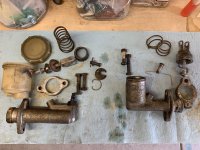KenF
Gold forum user
- Messages
- 396
Well, so far the rebuild of the brake and clutch master cylinders isn't going very well.  Pistons are stuck. Soaked overnight in Kroil penetrating oil, no luck. Tried air pushing from inside, nope. I'm hoping I can save these, even if they need to be sleeved. I've seen others use a grease fitting on the outlet and pushing grease through it, might work, idk. Any tips? Thanks!
Pistons are stuck. Soaked overnight in Kroil penetrating oil, no luck. Tried air pushing from inside, nope. I'm hoping I can save these, even if they need to be sleeved. I've seen others use a grease fitting on the outlet and pushing grease through it, might work, idk. Any tips? Thanks!


